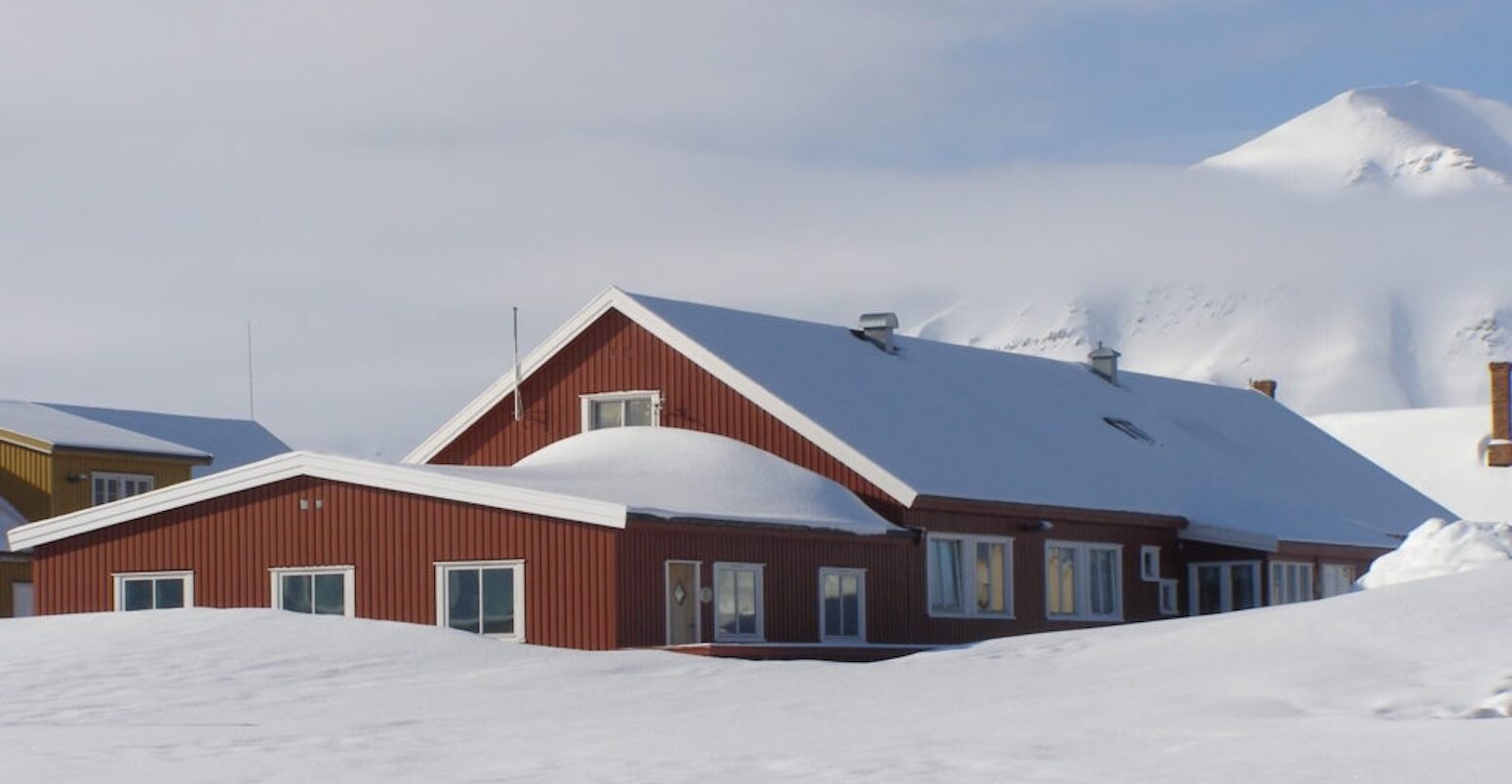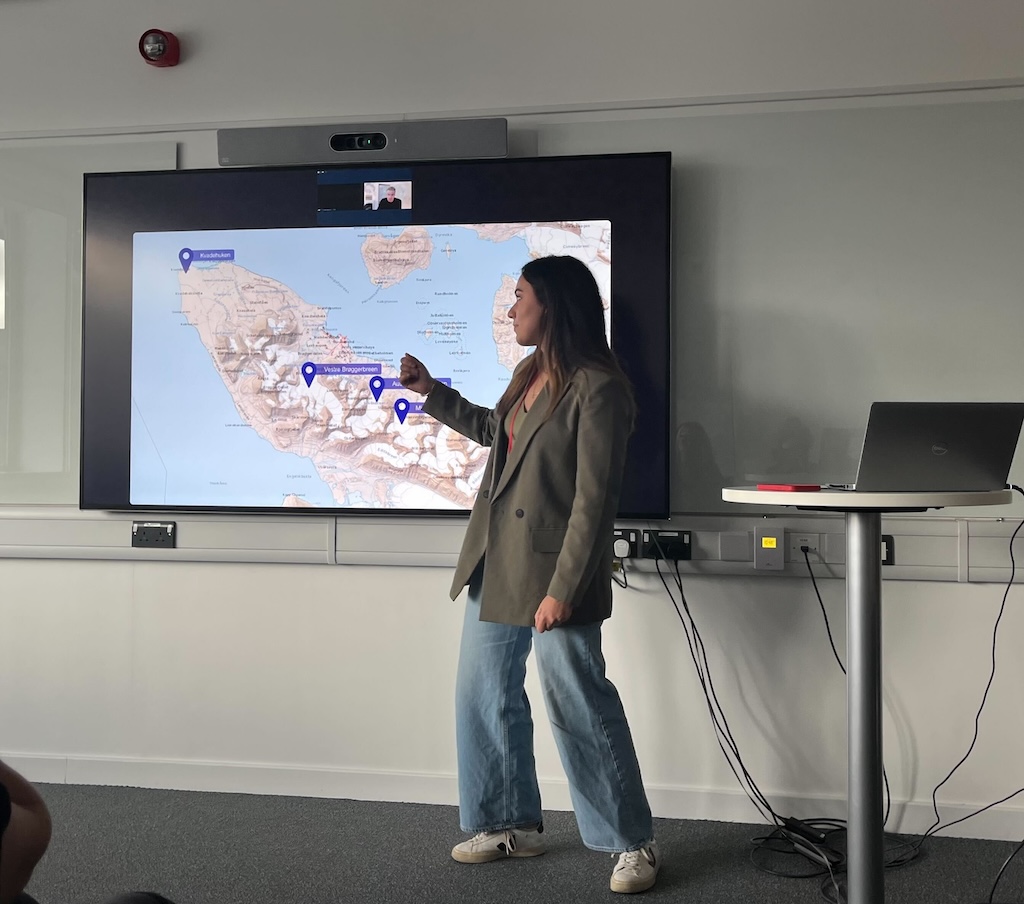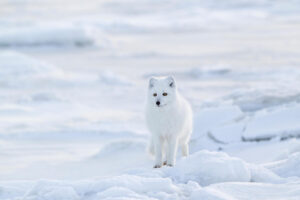
Ny-Ålesund: How UK scientists are studying climate change in the Arctic
Daisy Dunne
02.09.24Daisy Dunne
09.02.2024 | 10:39amThe northernmost town in the world, Ny-Ålesund, has for more than 30 years hosted the UK’s Arctic Research Station – the nation’s only permanent infrastructure at the Earth’s northern pole.
Located on the Norwegian island of Svalbard – one of the most rapidly warming regions on Earth – the station acts as a base for UK scientists studying the Arctic’s ice, ecosystems and atmosphere.
On 7 February, Carbon Brief was invited to the British Antarctic Survey (BAS), the UK’s national polar research institute in Cambridge, to hear more about what life is like for UK scientists living in the Arctic Circle.
BAS’s Arctic Day also offered a chance to hear about how researchers are working to understand the complex impacts of climate change on the land’s most northern edge.
UK Arctic base
Formerly a mining town, Ny-Ålesund now hosts Arctic research stations for a range of countries including China, France, Germany, India, Italy, the Netherlands, Norway and the UK.
It is accessible via a flight on a 14-seater plane that leaves four times a week from Longyearbyen, the largest town in Svalbard.
Speaking at BAS’s Arctic Day, the institute’s Arctic operations manager Iain Rudkin explained that the town is famous for being the starting point for a number of “crazy” Arctic expeditions.
This includes the expeditions of Roald Amundsen, the Norwegian explorer who was the first man to successfully navigate the treacherous Northwest Passage through the Arctic to North America by boat in 1905.

The UK’s Arctic Research Station was built in 1991. It consists of seven bedrooms, three laboratories, a sitting room, an office and storage space. The station can be explored room by room using this 3D virtual tour tool.
According to station lab manager Guy Hillyard, the labs consist of a general space, a microscopic lab and a wet lab suitable for processing dirty soils and sediments.
The station also has an annex for drying mosses and soils, freezers at temperatures from -18 to -25C for storing ice cores and separate freezers for storing frozen sediment, he added.

Until recently, Ny-Ålesund was a town of “radio silence”, meaning there was no wifi, bluetooth or other kinds of internet access. However, last year, a decision was made to install a 4G mast.
Although many living at Ny-Ålesund appreciated the radio silence, the decision was made to make it easier for people out in the field to call for help if in danger and to allow scientists to use scientific equipment that communicates via the internet, Rudkin said.
Algae, AI and invisible ecosystems
BAS’s Arctic Day saw a number of UK-based scientists briefly explain the purposes of their research at Ny-Ålesund in the past and coming few months.
Dr Jaz Millar, a postdoctoral researcher at the University of Bristol, travelled to Ny-Ålesund in July 2023 as part of their research into how climate change could be affecting algal blooms on glaciers, which are vast rivers of frozen ice.
The algae that Millar studies is dark purple, meaning it lowers the “albedo” on the surface of glaciers. Albedo is a term for describing the proportion of sunlight that is reflected away from a surface, with bright white having a high albedo and dark colours having a low albedo.
When the albedo on the glacier’s surface is lowered, it absorbs more sunlight. This causes it to melt faster.
It is possible that presence of meltwater induces the growth of more algae – potentially representing a self-reinforcing “worrying positive feedback loop”, Millar explained.
Around Ny-Ålesund, Millar’s team visited three glaciers. They studied algal growth with a range of techniques, including bringing microscopes directly into their field sites and taking ice samples.
Millar’s research has not yet been published, but the results suggest that the relationship between glacier melt and algal bloom growth may be more complex than just a linear positive feedback loop.
Elsewhere, Prof Kate Hendry, a chemical oceanographer at BAS, explained more about her research into how the melting of glaciers could be altering the flow of key nutrients into coastal waters – eventually impacting marine ecosystems.
She explained that glacier meltwater typically contains nutrients that are needed by diatoms – single-cell algae that act as food for tiny marine creatures called zooplankton – which in turn support a wide range of fish, bird and mammal species, including whales. These nutrients include iron nitrate and silicic acid.

As glaciers melt at an increasingly rapid rate because of climate change, this may impact the growth of diatoms – in turn affecting species higher up the food chain, she said.
To study this, Hendry’s team visited Ny-Ålesund in 2023 to collect more than 1,000 samples from glaciers, the ocean and sediments. Her team will return this year to look further at how the availability of iron and silicon in fjord environments could be affected by climate change.
At the sidelines of the presentations, Carbon Brief spoke to Martin Rogers, a machine-learning scientist at BAS, about his research using AI to map changes to Arctic sea ice in higher resolution than is currently available.
The AI tool can search through different types of satellite imagery, offering scientists the highest-resolution image available when considering factors such as cloud cover, which can obscure views of the sea ice, he explained.
In the future, this tool could be used to help scientists understand in greater detail the extent to which sea ice is declining because of climate change, he added:
“The big question is about the decline in sea ice extent. With this product, you can get the sea ice extent in high fidelity. Then you’ve got more precise information about how the sea ice extent is changing between years.”
Finally, the conference heard from Laura Molares Moncayo, a PhD student at the Natural History Museum and Queen Mary University of London.
Her research is centred around the question of whether the Arctic’s atmosphere could be supporting an ecosystem that is invisible to the human eye.
For decades, researchers assumed that glaciers were devoid of complex lifeforms, she explained. However, research has revealed that they actually support a vast array of microorganisms, which are well adapted for harsh, frozen environments.
How did these microorganisms find their way into glaciers?
Glaciers grow by receiving rain and snow from the atmosphere. In fact, glaciers could be considered a “condensed version of the atmosphere”, Molares Moncayo explained.
It is possible, she continued, that the microorganisms found in glaciers may have fallen from the atmosphere. Such microorganisms would, in theory, already possess the adaptations required to survive the tough conditions of the Arctic air.

In a week’s time, she will travel to Ny-Ålesund to try to establish whether the Arctic atmosphere is home to an invisible ecosystem of microorganisms.
To do this, she will use a range of equipment, including dry air samplers, which collect any solid particles present in air into a filter.
She will then use DNA sequencing techniques to identify which microorganisms are present in her air samples. She will also study the microorganisms’ functional genes, which will offer clues into whether the microorganisms are interacting with each other when still in the air.





